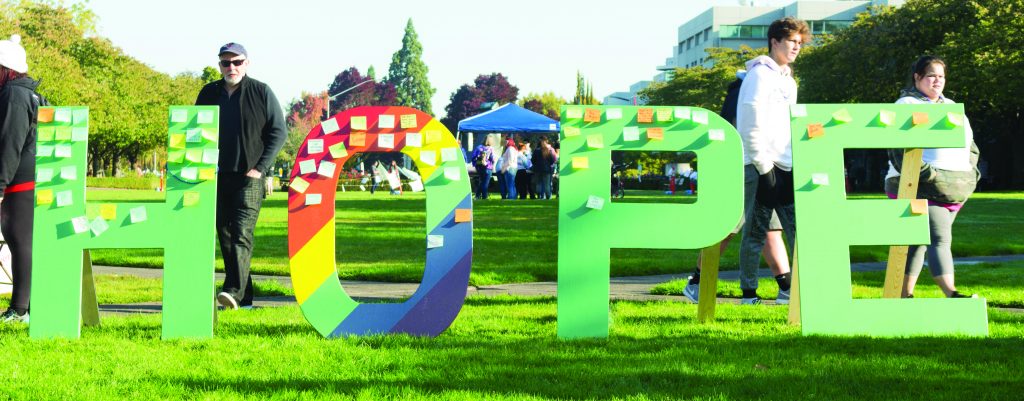
Bailey Thompson | News Editor
Holding signs and wearing t-shirts with messages about lost loved ones, over 1500 people gathered together at the Oregon State Capitol on Oct. 13 to participate in the Salem Out of the Darkness Walk for suicide awareness and prevention.
After all the participants had checked in, the event’s organizers stood on the steps of the capitol and offered a message of hope and support to everyone in attendance.
“Did you know that the mission of (American Foundation for Suicide Prevention) is a simple one? It’s only (10) words: save lives and bring hope to those affected by suicide. That’s it,” said Angela Perry, president of the Oregon Chapter board for AFSP. “Today is the perfect day to reflect, to remember those we have lost and to honor those who have struggled and are fighting to stay.”
According to AFSP’s 2018 statistics page, suicide is the second-leading cause of death for college-aged students in Oregon. Additionally, one person dies by suicide in Oregon every 11 hours. Because of statistics like these, Perry shared that AFSP is hosting nearly 400 community walks nationwide in order to raise funds for awareness of mental illness and suicide prevention.
“We’re all connected — connected by something none of us ever wanted a connection to,” Perry said. “Suicide is hard. It’s dark. But what we’re doing here today is bringing it out of the darkness: it’s okay to not be okay and you are not alone.”
Another speaker who shared her testimony before the crowd was 11-year-old Kelly Johnston, a middle school student who has become an advocate for suicide prevention, speaking at a number of AFSP events and even sharing her wisdom with graduate students at Lewis and Clark College.
“Two and a half years ago I lost my dad to suicide… every so often I would have dreams about how he had done it and what he may have been thinking. And often I’ve wondered where I would be if it wasn’t for counseling. Through counseling, I’ve been able to make speeches that I feel have made me mentally stronger,” said Johnston. “I love knowing that I might be helping someone out there — especially someone with depression. People who struggle with depression may feel that they will be judged if they ask for help or ask questions. Part of my mission is for people to know that it is okay to ask for help.”
After Johnston’s speech, the crowd was led through a traditional bead ceremony — a moment filled with emotion for many.
For each type of loss that a person had experienced, there was a different color of bead to wear. In turn, audience members raised red beads if they had lost a partner or spouse; gold beads if they had lost a parent; white beads if they had lost a child; orange beads if they had lost a sibling; silver beads if they had lost a military member or first responder; and purple beads if they had lost a friend or relative. Furthermore, there were also teal beads if their friend of relative struggles with or has attempted suicide, green beads if they themselves have struggled, and blue beads that showed their support for the cause.
To conclude, the crowd walked around the capitol building, taking time to remember their loved ones. At the end of the day, the event had raised $65,395.82.
For anyone currently struggling with the effects of suicide in some manner, there are resources that are available to help. Western students can call the Student Health and Counseling Center at (503) 838-8396 in order to set up a counseling appointment. Additionally, students can also call the National Suicide Prevention Lifeline any time at 1 (800) 273-8255.
Contact the author at howlnews@wou.edu
Photo courtesy of Ashlynn Norton

